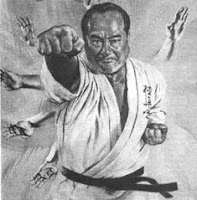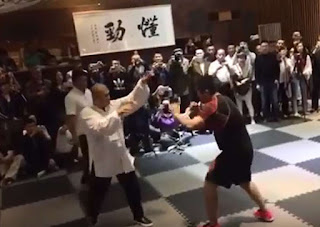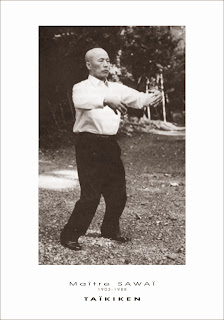Kata as a conditioning tool
 Many have written about the benefits and function of forms (Japanese – “kata”, Chinese – “xing”) as a means of grooving or drilling fighting combinations and, more relevantly, teaching principles of martial movement that can be carried through to combat in a more general sense. I have, in the past, also noted the importance of kata as a means of “packaging” martial knowledge – techniques, footwork, principles, etc. I can see that in the pre-written era kata would have been the primary means of preserving and transmitting such knowledge and, to some extent, this purpose is largely unchanged: kata can and should function effectively as an “encyclopaedia”.
Many have written about the benefits and function of forms (Japanese – “kata”, Chinese – “xing”) as a means of grooving or drilling fighting combinations and, more relevantly, teaching principles of martial movement that can be carried through to combat in a more general sense. I have, in the past, also noted the importance of kata as a means of “packaging” martial knowledge – techniques, footwork, principles, etc. I can see that in the pre-written era kata would have been the primary means of preserving and transmitting such knowledge and, to some extent, this purpose is largely unchanged: kata can and should function effectively as an “encyclopaedia”.However recently I participated in a forum discussion where the question was raised whether kata could be at all useful in modern sports combat, eg. MMA (Mixed Martial “Arts”). Inevitably strong opinions were expressed that it could not. The common view among those who train in MMA and UFC (Ultimate Fighting Competition) type disciplines is that kata is largely purposeless – an anachronism that has been superseded by more modern and effective methods of developing combat skills. This is due, in large part I think, to the lack of success that traditional martial artists had in the original UFC bouts in the early 90s and the reluctance of many to try traditional techniques and training methods in this sporting context ever since.
While I disagree with the view that traditional martial arts techniques wouldn’t work in the MMA arena (I can see many techniques that could be improved by using more traditional approaches, the front kick being one) I sought to advance the view that regardless of its technical application, kata was an excellent conditioning tool if nothing else.
I gave the example that performing full-power, end-on-end repetitions of a difficult kata such as seiyunchin was the closest I had come in solo training to the fatigue felt in sparring (I think the fatigue of real combat or MMA is much harder to replicate in any sense because you need adrenalin, fear etc., so I'm not going there nor have I ever sought to).
Nenad performing seiyunchin kata
Now why do I feel that kata is better than other solo training methods such as shadow boxing? The formality, the low stances, tension, explosive movements, the pre-arranged format (so that, unlike shadow boxing, you don't "run out of ideas" or start doing easier moves subconsciously when you get fatigued) are all factors that apply.
I have a lot of time for shadow boxing. In my view, kata is like shadow boxing, but with resistance added in the form of a compulsory "roadmap" of formality and precision (which is hard to maintain when you get tired), low stances, transition from stance to stance and difficult turns (all conditioning the tendons and ligaments as well as the muscles).
The added stress of this formality has the function of rapidly taking you above your VO2 maximum – in much the same way as “shuttle runs” do in rugby training. I have deliberately referred to seiyunchin kata because it has a high percentage of “extra load”: there are more shiko dachi (horse stances), more deep lunges, sustained fast exchanges and explosive movements.
I gave the example that at the peak of my fitness (in around 1997) I once did 40 full-power seiyunchin in a row and felt like it almost killed me. Inevitably this was misinterpreted as proof that kata was inappropriate for MMA fighting where rounds are short, sustained and rapidly take you into anaerobic respiration. However the point I was making was that, at the relevant time, I was exceptionally fit in an anaerobic sense. I couldn’t do more than a handful now before flagging in power or speed. It is also worth noting that I was able to perform shuttle runs very well at that time despite never having trained in them before – in other words kata and other traditional training methods had developed my anaerobic fitness exceptionally.
 In conditioning terms, which kata you perform is important. As an example, in around 1989 I performed over 300 fukyugata ichi in a row (our version is similar to heian shodan) and I did not feel the same level of anaerobic fatigue. In other words, this was more an aerobic activity than an anaerobic one. Lately I have found that some of the "bridging" forms of Hong Yi Xiang - in particular a form called "Da Peng Zhan Chi" - are even more useful for conditioning.
In conditioning terms, which kata you perform is important. As an example, in around 1989 I performed over 300 fukyugata ichi in a row (our version is similar to heian shodan) and I did not feel the same level of anaerobic fatigue. In other words, this was more an aerobic activity than an anaerobic one. Lately I have found that some of the "bridging" forms of Hong Yi Xiang - in particular a form called "Da Peng Zhan Chi" - are even more useful for conditioning.A question was raised as to whether I felt kata was better than bag work. My answer is that kata provides different conditioning. I wouldn't replace bag work with kata. Bag work alone however has its limitations - if it didn't boxers wouldn't do skipping, shadow boxing, speedball, floor to ceiling ball, etc.
Accordingly I believe kata has a role as a solo conditioning tool. Partner work might provide a better means of conditioning, but not everyone has the luxury of a training partner at just the right times. Conditioning tools must also be as muscle-specific as possible, so kata (with its martial movements, albeit formal ones) has advantages over skipping, running or other callisthenics that are not martial-related in any sense.
Copyright © 2008 Dejan Djurdjevic



Comments
Post a Comment